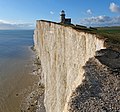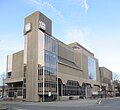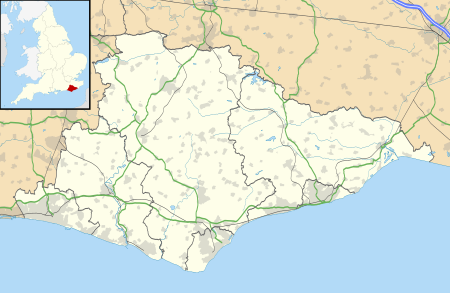Portal:East Sussex
 From Wikipedia the free encyclopedia
From Wikipedia the free encyclopedia

East Sussex is a ceremonial county in South East England. It is bordered by Kent to the north-east, West Sussex to the west, Surrey to the north-west, and the English Channel to the south. The largest settlement is the city of Brighton and Hove, and the county town is Lewes.
The county has an area of 1,792 km2 (692 sq mi) and a population of 822,947. The latter is largely concentrated along the coast, where the largest settlements are located: Brighton and Hove (277,105), Eastbourne (99,180), and Hastings (91,490). The centre and north of the county are largely rural, and the largest settlement is Crowborough (21,990). For local government purposes, East Sussex comprises a non-metropolitan county, with five districts, and the unitary authority of Brighton and Hove. East Sussex and West Sussex historically formed a single county, Sussex.
East Sussex is part of the historic county of Sussex, which has its roots in the ancient kingdom of the South Saxons, who established themselves there in the 5th century AD, after the departure of the Romans. Archaeological remains are plentiful, especially in the upland areas. The area's position on the coast has also meant that there were many invaders, including the Romans and later the Normans, following the defeat of the English army by William the Conquerer at the Battle of Hastings in 1066. Earlier industries included fishing, iron-making, and the wool trade, all of which have declined or been lost completely. (Full article...)
Selected article
Seaford is a town in East Sussex, England, east of Newhaven and west of Eastbourne.
In the Middle Ages, Seaford was one of the main ports serving Southern England, but the town's fortunes declined due to coastal sedimentation silting up its harbour and persistent raids by French pirates. The coastal confederation of Cinque Ports in the mediaeval period consisted of forty-two towns and villages; Seaford was included under the "Limb" of Hastings. Between 1350 and 1550, the French burned down the town several times. In the 16th century, the people of Seaford were known as the "cormorants" or "shags" because of their enthusiasm for looting ships wrecked in the bay. Local legend has it that Seaford residents would, on occasion, cause ships to run aground by placing fake harbour lights on the cliffs.
Seaford's fortunes revived in the 19th century with the arrival of the railway connecting the town to Lewes and London. It became a small seaside resort town, and more recently a dormitory town for the nearby larger settlements of Eastbourne and Brighton, as well as for London.
The traditional Sussex pronunciation of the name has a full vowel in each syllable: /ˈsiːfɔːrd/ "sea-ford". However, outside Sussex, and increasingly within, it is commonly pronounced with a reduced vowel on the second syllable: /ˈsiːfərd/ SEE-fərd. (Full article...)
Selected images
Selected biography
Archibald Stansfeld Belaney (September 18, 1888 – April 13, 1938), commonly known as Grey Owl, was a popular writer, public speaker and conservationist. Born an Englishman, in the latter years of his life he passed as half-Indian, claiming he was the son of a Scottish man and an Apache woman. With books, articles and public appearances promoting wilderness conservation, he achieved fame in the 1930s. Shortly after his death in 1938, his real identity as the Englishman Archie Belaney was exposed. He has been identified as one of the first pretendians (person with no indigenous ancestry, claiming to be indigenous) in Canada.
Moving to Canada as a young man, Belaney established himself as a woodsman and trapper, before rising to prominence as an author and lecturer. While working for the Dominion Parks Branch of Canada in the 1930s, Belaney was named the "caretaker of park animals", first at Riding Mountain National Park in Manitoba and then at Prince Albert National Park in Saskatchewan. His views on wilderness conservation, expressed in numerous articles, books, lectures and films, reached audiences beyond the borders of Canada, bringing attention to the negative impact of exploiting nature and the urgent need to develop respect for the natural world. He was particularly concerned about the plight of the beaver (Canada's national animal), which by the 1920s had been hunted almost to extinction.
Recognition of Belaney includes biographies, academic studies, historic plaques in England, Ontario and Quebec, and a film based on his life, directed by Richard Attenborough. (Full article...)
Did you know that

Long Man of Wilmington is 227 feet (69 metres) tall and designed to look proportional when viewed from below
General images -
List articles

- List of hills of East Sussex
- List of local nature reserves in East Sussex
- List of monastic houses in East Sussex
- List of museums in East Sussex
- List of Parliamentary constituencies in East Sussex
- List of places in East Sussex
- List of settlements in East Sussex by population
- List of Sites of Special Scientific Interest in East Sussex
- List of windmills in East Sussex
Subcategories
Settlements map
Things you can do
- Add to this portal.
- Join the Sussex WikiProject
Topics
Related portals
Associated Wikimedia
The following Wikimedia Foundation sister projects provide more on this subject:
- Commons
Free media repository - Wikibooks
Free textbooks and manuals - Wikidata
Free knowledge base - Wikinews
Free-content news - Wikiquote
Collection of quotations - Wikisource
Free-content library - Wikiversity
Free learning tools - Wikivoyage
Free travel guide - Wiktionary
Dictionary and thesaurus
























































































